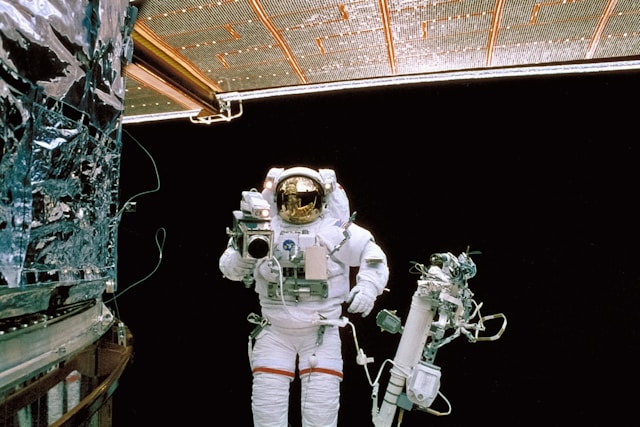Artificial intelligence has become one of the most transformative tools in modern science, and its role in space research is nothing short of revolutionary. With the vastness of the universe and the complexity of astronomical data, researchers are turning to AI in space research to unlock mysteries that were once beyond human reach. From analyzing massive datasets collected by satellites to guiding autonomous spacecraft millions of kilometers away, AI is enabling discoveries at a speed and scale never seen before.
How AI Works in Space Research
Artificial intelligence in astronomy involves using machine learning algorithms and advanced computing systems to process, analyze, and interpret astronomical data. Space missions generate terabytes of information daily, ranging from high-resolution images of distant planets to sensor readings from spacecraft systems. AI can filter through this data, identify patterns, and make predictions far faster than traditional methods.
In space exploration, the use of AI often combines three key elements: data collection, automated decision-making, and predictive modeling. This means spacecraft, telescopes, and satellites equipped with AI can operate semi-independently, adapting to changing conditions without waiting for instructions from Earth a crucial advantage when dealing with communication delays in deep space.
Key Applications of AI in Space Research
Satellite Data Analysis
AI in satellite data analysis has dramatically reduced the time needed to process complex information from orbiting instruments. It can automatically detect anomalies, map planetary surfaces, and identify geological changes on Earth and other planets. This allows scientists to prioritize the most important data for further study.
Autonomous Navigation
AI-powered spacecraft can perform autonomous navigation, adjusting their course and avoiding hazards without human intervention. This technology is essential for missions traveling to distant planets or moons where real-time communication is impossible due to signal delays.
Planet and Star Detection
Machine learning in space science has improved our ability to detect exoplanets and new stars. AI-powered telescopes can scan the skies and identify promising planetary candidates by recognizing subtle patterns in light curves and other astronomical data that might otherwise go unnoticed.
Predictive Maintenance
In long-duration space missions, equipment failure can be catastrophic. AI can perform predictive maintenance by analyzing sensor readings to forecast when components might fail, enabling repairs or adjustments before problems arise.
Mission Planning and Optimization
AI assists in mission planning and optimization by analyzing fuel consumption, trajectory efficiency, and time management. It can simulate thousands of possible routes and scenarios, helping agencies choose the most effective mission plans.
Real-World Examples of AI in Space Exploration
NASA has integrated AI into several projects, such as the Mars rovers that use autonomous navigation to explore the Martian surface. The Hubble Space Telescope’s image analysis also employs AI to classify galaxies and identify distant cosmic structures.
The European Space Agency uses AI for asteroid detection, improving our ability to spot potential threats to Earth. Google’s AI algorithms, in collaboration with NASA, have even discovered new exoplanets by reanalyzing data from the Kepler Space Telescope.
Benefits of AI in Space Research
The use of artificial intelligence in space research offers numerous advantages:
-
Faster data analysis — turning months of work into hours.
-
Reduced human risk — allowing machines to handle dangerous and remote exploration tasks.
-
Lower operational costs — optimizing mission resources.
-
Greater adaptability — enabling equipment to function effectively in unpredictable environments.
Challenges and Limitations
Despite its promise, AI in space exploration faces challenges. Data accuracy can be affected by noise and environmental factors. There are ethical concerns over the extent of AI autonomy in decision-making, especially in critical missions. Additionally, computational systems must be capable of operating reliably in the harsh conditions of space, where extreme temperatures, radiation, and limited power supply can disrupt functionality.
The Future of AI in Space Research
Looking ahead, AI in astrophysics and space exploration will become even more sophisticated. We can expect AI-driven interstellar probes capable of exploring distant star systems with minimal human input. The integration of quantum computing with AI could also revolutionize how we analyze cosmic data, allowing for near-instant processing of massive datasets.
Collaborations between space agencies, tech companies, and research institutions will further expand the capabilities of AI in space science. From mapping uncharted galaxies to predicting the behavior of black holes, the future possibilities are limitless.
Conclusion
Artificial intelligence is no longer just a support tool, it is an essential partner in the quest to explore the universe. By processing astronomical data, guiding spacecraft, and enabling autonomous decision-making, AI is transforming the way we conduct space research. As technology continues to advance, AI will play an even greater role in uncovering the secrets of the cosmos, pushing humanity further into the final frontier.

